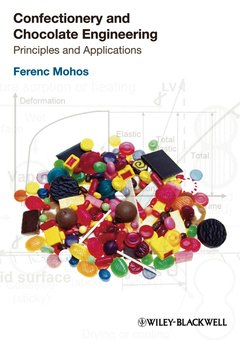Confectionery & chocolate engineering Principles & applications
Auteur : MOHOS Ferenc

The purpose of this book is to describe the features of unit operations used in confectionary manufacturing. In contrast to the common technology-focused approach to this subject, this volume offers a scientific, theoretical account of confectionery manufacture, building on the scientific background of chemical engineering. The large diversity of both raw materials and end products in the confectionery industry makes it beneficial to approach the subject in this way. The industry deals with a variety of vegetable based raw materials as well as milk products, eggs, gelatin, and other animal-based raw materials. A study of confectionery and chocolate engineering must therefore examine the physical and chemical, as well as the biochemical and microbiological properties of the processed materials. By characterizing the unit operations of confectionery manufacture the author, who has over 40 years’ experience in confectionery manufacture, aims to open up new possibilities for improvement relating to increased efficiency of operations, the use of new materials, and new applications for traditional raw materials.
The book is aimed at food engineers, scientists, technologists in research and industry, as well as graduate students on relevant food and chemical engineering-related courses.
Acknowledgements.
Part I Theoretical introduction.
Chapter 1 Principles of food engineering.
1.1 Introduction.
1.2 The Damköhler equations.
1.3 Investigation of the Damköhler equations by means of similarity theory.
1.4 Analogies.
1.5 Dimensional analysis.
1.6 The Buckingham Π, theorem.
Further reading.
Chapter 2 Characterization of substances used in the confectionery industry.
2.1 Qualitative characterization of substances.
2.2 Quantitative characterization of confectionery products.
2.3 Preparation of recipes.
Chapter 3 Engineering properties of foods.
3.1 Introduction.
3.2 Density.
3.3 Fundamental functions of thermodynamics.
3.4 Latent heat and heat of reaction.
3.5 Thermal conductivity.
3.6 Thermal diffusivity and Prandtl number.
3.7 Mass diffusivity and Schmidt number.
3.8 Dielectric properties.
3.9 Electrical conductivity.
3.10 Infrared absorption properties.
3.11 Physical characteristics of food powders.
Chapter 4 The rheology of foods and sweets.
4.1 Rheology: its importance in the confectionery industry.
4.2 Stress and strain.
4.3 Solid behaviour.
4.4 Fluid behaviour.
4.5 Viscosity of solutions.
4.6 Viscosity of emulsions.
4.7 Viscosity of suspensions.
4.8 Rheological properties of gels.
4.9 Rheological properties of sweets.
4.10 Rheological properties of wheat fl our doughs.
Chapter 5 Introduction to food colloids.
5.1 The colloidal state.
5.2 Formation of colloids.
5.3 Properties of macromolecular colloids.
5.4 Properties of colloids of association.
5.5 Properties of interfaces.
5.6 Electrical properties of interfaces.
5.7 Theory of colloidal stability: the DLVO theory.
5.8 Stability and changes of colloids and coarse dispersions.
5.9 Emulsion instability.
5.10 Phase inversion.
5.11 Foams.
Part II Physical operations.
Chapter 6 Comminution.
6.1 Changes during size reduction.
6.2 Rittinger"s "surface" theory.
6.3 Kick"s "volume" theory.
6.4 The third, or Bond, theory.
6.5 Energy requirement for comminution.
6.6 Particle size distribution of ground products.
6.7 Particle size distributions.
6.8 Kinetics of grinding.
6.9 Comminution by fi ve-roll refi ners.
6.10 Grinding by a melangeur.
6.11 Comminution by a stirred ball mill.
Chapter 7 Mixing/kneading.
7.1 Technical solutions to the problem of mixing.
7.2 Power characteristics of a stirrer.
7.3 Mixing-time characteristics of a stirrer.
7.4 Representative shear rate and viscosity for mixing.
7.5 Calculation of the Reynolds number for mixing.
7.6 Mixing of powders.
7.7 Mixing of fl uids of high viscosity.
7.8 Effect of impeller speed on heat and mass transfer.
7.9 Mixing by blade mixers.
7.10 Mixing rolls.
7.11 Mixing of two liquids.
Chapter 8 Solutions.
8.1 Preparation of aqueous solutions of carbohydrates.
8.2 Solubility of sucrose in water.
8.3 Aqueous solutions of sucrose and glucose syrup.
8.4 Aqueous sucrose solutions containing invert sugar.
8.5 Solubility of sucrose in the presence of starch syrup and...
Date de parution : 09-2010
Ouvrage de 656 p.
24.4x16.8 cm
Disponible chez l'éditeur (délai d'approvisionnement : 12 jours).
Prix indicatif 218,97 €
Ajouter au panier


